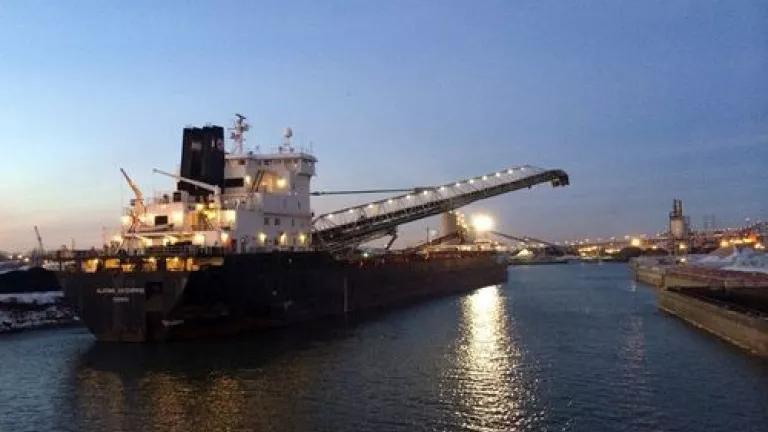Petroleum Coke on the Move: BP Whiting's coke leaves Chicago, is headed for Kentucky and Virginia communities

Since last February, when BP announced that it would no longer send the Whiting Refinery's 2 million annual tons of petroleum coke through Chicago via KCBX as of summer 2015, we've been wondering: where is the coke going, and is it burdening some other community?
We now have confirmation that the Whiting refinery's dirty tar sands waste is heading to at least two locations, a Southern Coal Handling facility in Kentucky and an export facility in Newport News, Virginia, on its way out of the country.
There are a few important takeaways from this news:
Nothing required that KCBX store BP's millions of tons of oily waste in Chicago next to densely populated urban neighborhoods. After the City responded to residents' outcries by adopting more stringent regulations for coke and coal dust, the oil company shifted where it sends its waste. That's 2 million tons less dirty, dusty material showing up next to Chicago homes and parks and schools, at least in terms of BP's waste. Indeed, throughput reports by KCBX show that incoming pet coke delivered by rail (the mode used by BP to deliver coke to KCBX) dropped by about 100,000 tons per month on average as of June 2015 (of note, KCBX appears to be getting more coke by truck now, ostensibly from another refinery).
It's also 2 million tons less coke moving by ship and uncovered barge on Chicago's waterways every year. As we've pointed out in our recent report Revitalizing the Chicago Area Waterway System and as explained in the accompanying technical report by leading transportation firm Cambridge Systematics, coke and coal movements on the Chicago Area Waterway System (CAWS) are expected to decline significantly over the coming years. However, other recent projections of freight on Chicago's waterways in the Great Lakes and Mississippi River Interbasin Study (GLMRIS) - which looked at how to prevent Asian carp and other aquatic invasive species from decimating these national treasures - do not adequately take into account this downward movement of fossil fuels traveling on the water.
The GLMRIS analysis was based on 2012 input - a time when folks like the U.S. Marine Administration thought that coal would continue to power numerous plants around the Great Lakes, and Midwest refineries were planning big tar sands projects that would increase their pet coke production. GLMRIS thus projected that coal and petroleum products like coke would account for more than a third of goods moving on the CAWS in the coming years (see page D-680). Given announced changes in our region's electricity generating mix and refineries' plans to hold off on tar sands projects, not to mention the City's dust regulations, these projections are outdated and just plain wrong. GLMRIS and other similar assessments of freight also fail to adequately acknowledge that businesses using the CAWS for goods movement have other options, as BP does - and could have even more if we took a serious look at where goods are coming from and going to, and commit to modernizing and synchronizing all of our freight modes to reduce impacts on communities.
On the other hand, it's 2 million more tons of coke for Newport News and communities along the Ohio River, who have their own histories of battling dirty coal and coke facilities. According to one 2011 article, Newport News has been feeling the impacts of coal handling facilities for decades, including an asthma rate in the surrounding community that's more than double the citywide and state averages. Even the president of one Newport News coal terminal company acknowledged that the proximity to neighborhoods is a problem. And Metropolis, Illinois, has opposed Southern Coal Handling's plans for a coal and coke handling facility across the river in Kentucky out of concerns for potential dust impacts on its downtown riverfront. Since we don't have specific information about which sites in Kentucky and Virginia are taking in BP's coke, we can't opine directly on the potential implications for these communities. But given this history in both places, concern seems warranted. As NRDC and Senator Durbin have emphasized, we need to ensure that the petroleum coke problem doesn't just end up in someone else's community.
Finally, BP Whiting's tar sands expansion not only produces three times more of this burdensome waste than the refinery's previous operations, but also creates petroleum coke that U.S. companies will not use. So this dirty chain leading from the refinery to communities throughout the country does not benefit domestic companies along the way, and ends in us exporting our waste to places with even fewer protections for health and the environment. No wonder President Obama stood up and rejected the Keystone Pipeline on the basis that dirty tar sands crude is not the right direction for America's - or our globe's - future.
Photo of ship docked at former Beemsterboer site on Chicago's Southeast Side
